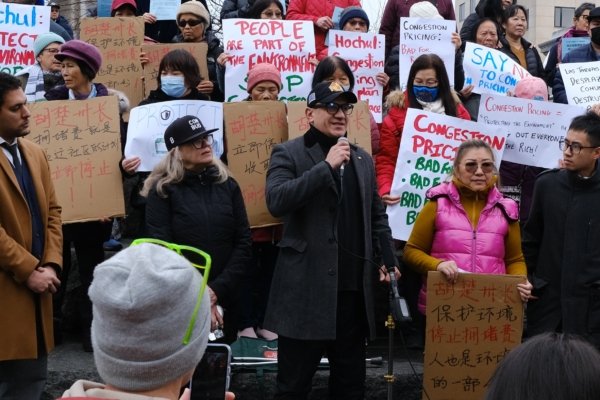On December 17, more than 50 residents, tenants, workers, and small business owners from Manhattan’s Chinatown and the Lower East Side held a press conference demanding the governor to halt the Congestion Pricing plan and adopt better alternative solutions to tackle the traffic congestion issue.
The press conference was organized jointly by the Coalition to Protect Chinatown and the Lower East Side and the LES Small Business Alliance. Participants expressed concerns about the high vacancy rates of 16-20% in the shops in Chinatown and the Lower East Side. They emphasized the importance of protecting both the environment and employment, improving public transportation, and avoiding policies that favor developers to prevent further harm to the local community.
In June this year, New York Governor Kathy Hochul mentioned that implementing congestion pricing at this time would pose risks of unimaginable consequences for New Yorkers. She urged the Metropolitan Transportation Authority (MTA) to indefinitely postpone the implementation of the congestion pricing plan. However, following the November elections, it was swiftly announced that the congestion pricing plan for the Manhattan central business district would resume on January 5 next year. Opponents believe that this will severely impact the middle class.
Participants emphasized that congestion pricing will negatively impact local small businesses and become the “last straw” for many businesses in Chinatown and the Lower East Side.
Francisco Gonzalez, the founder of the LES Small Business Alliance, pointed out that congestion pricing would have a serious impact on small businesses, especially minority-owned small businesses. He stated, “Our food costs will rise, rent is already very high, and this additional cost will further force our community residents to leave.”
Song Meirong, a tenant in Chinatown and former small business owner, witnessed the transition of Chinatown from prosperity to decline due to government policies favoring large developers. She believes that implementing congestion pricing will further reduce foot traffic in Chinatown, adding to the challenges faced by small businesses.
Cliff, a young Chinese-American running a small business with his parents locally, also expressed concerns about the difficulties in continuing their operations due to congestion pricing.
Residents urged the governor to “do the right thing” and emphasized that environmental protection should be “people-oriented,” calling for actions that truly benefit the community.
Maggie Martinez, a Lower East Side resident, noted that even with congestion pricing, affluent vehicles would still traverse the streets, while community residents would be forced to relocate due to congestion fees and air pollution.
Sabrina Fang, a member of the Youth Against Displacement (YAD) group, emphasized that people are also a part of the environment and urged the governor to prioritize the working class. She criticized Governor Hochul’s reasoning for the plan, suggesting controlling MTA’s spending waste instead of continuously seeking funds from the working class.
Elected officials viewed this plan as another form of taxation on the working class, leading to shop closures and job losses for the working class.
Former City Council Member and retired Supreme Court Judge Kathryn Freed stated that the plan failed to consider the negative impact of congestion pricing on tenants and small businesses in Chinatown and the Lower East Side. She emphasized that this would harm the most marginalized residents, increase costs of food, deliveries, and services, and make it difficult for small businesses to survive, resulting in job losses.
Council Member Christopher Marte questioned the purpose of Governor Hochul’s plan, describing it as an additional tax burden on the community. He asked, “Why should the residents of our community pay this tax? This is a working-class community, a low-income community… Who does this plan truly serve, and who will be forced to leave?”
According to the latest report from the New York City Planning Department, the commercial vacancy rates within the congestion pricing coverage area are among the highest in the city, with Chinatown and the Two Bridges community having a vacancy rate of 20%, and the Lower East Side at 16%. They called on the governor to reconsider the impact of congestion pricing and implement fairer and more effective solutions to protect the livelihoods of community residents and businesses.

